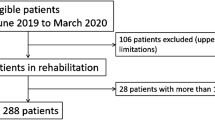Abstract
A work-related repetitive trauma disorder to the lumbar spine was treated effectively with initial appropriate Physical Therapy Modalities followed by a Dynamic “Active” approach. Return-to-work orders, duties restriction, and improvement were substantiated with regular Functional Capacity Evaluations, following NIOSH guidelines intermediate level of the lifting task evaluation. Job Strength Rating (JSR) calculations were made concerning ability to return to work by calculating repetitions into the equation. Upon obtaining acceptable JSR readings, the patient was allowed to return to work on a graduated scale and a mild exacerbation was experienced. Due to this incident, functional exercises were developed to help achieve higher repetition movements, thus satisfying his high repetitious job duty specifications. By reviewing the findings, we were able to categorize this patient as a Qualified Injured Worker enabling him vocational rehabilitation. The most effective component to his release was the development of functional dynamic lifting task exercises, and calculation of his Job Strength Rating, remembering the importance of repetitions, and its effect on true Functional Capacity.
Similar content being viewed by others
REFERENCES
Bigos et al. A prospective study of work perceptions and psychosocial factors affecting the report of back injury. Spine 1991; 16: 1-6.
J Occup Med 1982; 24(10).
Astrand P. Work Physiol 1992.
Haldeman. Failure of the pathology model to predict back pain. Spine 1988; 13: 345-350; 1990; 15.
National Institute of Occupational Safety and Health: Guidelines, Department of Labor, 1991.
Graves JE, Pollack ML. Effects of training frequency and specificity. Spine 1990; 15: 504-509.
Roy S, Irvin R. Sports medicine prevention, evaluation, management, and rehabilitation. Englewood Cliffs: Prentice Hall, 1983.
American Academy of Orthopedic Surgeons. Athletic Training in Sports Medicine. Chicago: The American Academy of Orthopedic Surgeons, 1984.
Drury et al. Dynamic and static lifting tasks. U.S. Department of Labor, 1982.
Author information
Authors and Affiliations
Rights and permissions
About this article
Cite this article
Reyes, D.J. Repetition in Clinical Job Strength Rating Calculations: Facilitating Safe Dynamic Rehabilitation in a Lumbar Cumulative Trauma Injury. J Occup Rehabil 8, 273–280 (1998). https://doi.org/10.1023/A:1023029819318
Issue Date:
DOI: https://doi.org/10.1023/A:1023029819318




